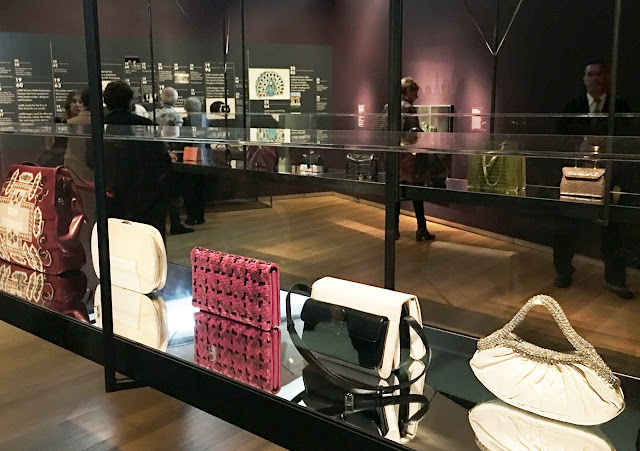Fish minaudière w/rhinestones (1978)
Clutching a green toolbox, 26-year-old Judith Leiber landed in New York City in 1946. The box--credentials of a master craftswoman (and an ironic foreshadowing of minaudières to come)--signified both saving grace and an unusual ability to craft handbags from dream to designer showroom. As a Jew living at the height of Nazism, opportunity materialized in the form of family connections and a job at prestigious purse company Pessl. Trading chemistry and a future in the cosmetics industry for bag-making, 3,500+ exotic and Swarovski crystal-encrusted handbags were brought to life. Until August 6th, the Museum of Arts and Design celebrates the legacy of Judith Leiber through Judith Leiber: Crafting a New York Story--the second in a three-part series on craft. Keep reading for a look inside...
Tiffany Gallery installation view
Designing handbags became the mental mechanism for survival, as Leiber and her family settled in basements and other crowded 'safe' spaces during Nazi occupation. When American troops arrived in Europe, the air lightened; Leiber was commissioned to create bags for the secretaries of the American Legion through a mutual friend. On the streets of post-Nazi recovery, a young Judith Peto met and married artist Gerson Leiber. The pair moved to the Bronx (NYC) and Judith's humble beginnings saw the inside of several fashion houses before Mamie Eisenhower validated Leiber's skill by wearing a Leiber design (under the Nettie Rosenstein label) at the 1953 inaugural ball.
[L] Violin pillbox with rhinestones (1992, [R] Venetian Lady minaudière w/rhinestones (1989)
At the age of 42, Leiber--with the help of her husband--began producing her own handbags and peddling them to friends and contacts. Fine frames and exotic materials were sourced from Japan (silk, obis), India (Parisi ribbons), Iran and Africa. Chatelaine was Leiber's first metal-and-rhinestone-encrusted bag. Meant to be made from gold/silver plated brass, the samples arrived with discolored green streaks due to shoddy electric processing; Leiber used crystals to mask the imperfections... and a luxury bag was born! The Chatelaine helped quadruple revenue, thus becoming a cornerstone of the Judith Leiber brand.
[L] Violin minaudière w/rhinestones, [R] Drama pillbox w/rhinestones (1988)
From humble beginnings, Leiber has since found favor with celebrities and designers, who often send gown sketches to be paired with her bags. At her peak, Leiber's 5-person operation grew to four floors and 20,000 square feet. Viewing her collection, art deco touches and jewel encrusted animals / produce are familiar finds under the Judith Leiber label (though seashells and exotic skins have had a strong showing).
Installation endcap
The MAD exhibit includes a broad sampling of Leiber's work including the penguin--one of her favorites. The long glass planks and mirrored surfaces expertly showcase Leiber's elaborate bags, highlighting the effervescent properties of the crystal and/or fabric textures. The Tiffany & Co. Foundation Jewelry gallery presents a view of the bags created for past Presidents (of their pets). Definitely worth a visit for handbag fans. Click here for related events.
Re-embroidered Japanese obi frame bag w/rhinestones and jet beads (1987)
[L] Python clutch w/onyx + agate, [R] Red python bag w/gold ball closure + chain (1989)
Re-embroidered Indian Parsi Ribbon frame bag w/rhinestones (1977)
Installation view--suspended cases!
Back gallery installation view
White charring frame bag with cornelian and agate (1981)
Nautilus shell minaudière w/ gold-plated lid (1972)
Sea urchin minaudière with gold plated lid (1972)
US Flag miniaudiere w/ rhinestones and gold tassel
Fuchsia embroidered karung envelope with tassel and amethyst lock (1973)
















No comments:
Post a Comment